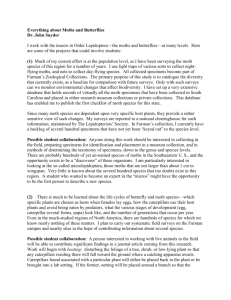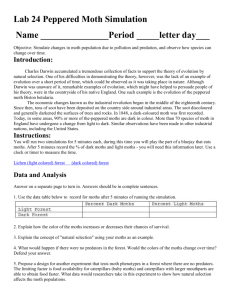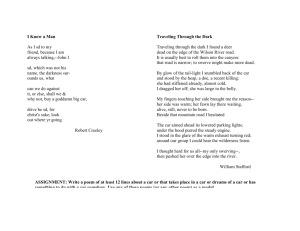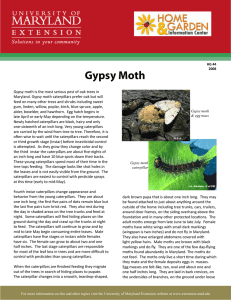19 September 2002 White-lined Sphinx in Arizona Carl A. Olson Department of Entomology
advertisement
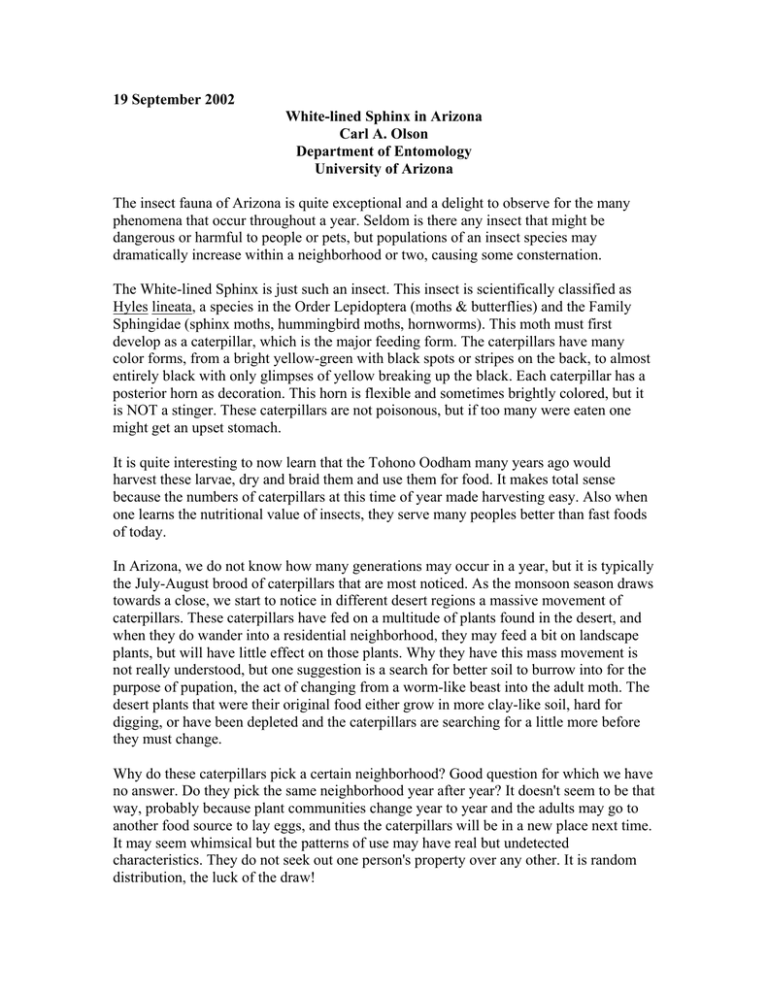
19 September 2002 White-lined Sphinx in Arizona Carl A. Olson Department of Entomology University of Arizona The insect fauna of Arizona is quite exceptional and a delight to observe for the many phenomena that occur throughout a year. Seldom is there any insect that might be dangerous or harmful to people or pets, but populations of an insect species may dramatically increase within a neighborhood or two, causing some consternation. The White-lined Sphinx is just such an insect. This insect is scientifically classified as Hyles lineata, a species in the Order Lepidoptera (moths & butterflies) and the Family Sphingidae (sphinx moths, hummingbird moths, hornworms). This moth must first develop as a caterpillar, which is the major feeding form. The caterpillars have many color forms, from a bright yellow-green with black spots or stripes on the back, to almost entirely black with only glimpses of yellow breaking up the black. Each caterpillar has a posterior horn as decoration. This horn is flexible and sometimes brightly colored, but it is NOT a stinger. These caterpillars are not poisonous, but if too many were eaten one might get an upset stomach. It is quite interesting to now learn that the Tohono Oodham many years ago would harvest these larvae, dry and braid them and use them for food. It makes total sense because the numbers of caterpillars at this time of year made harvesting easy. Also when one learns the nutritional value of insects, they serve many peoples better than fast foods of today. In Arizona, we do not know how many generations may occur in a year, but it is typically the July-August brood of caterpillars that are most noticed. As the monsoon season draws towards a close, we start to notice in different desert regions a massive movement of caterpillars. These caterpillars have fed on a multitude of plants found in the desert, and when they do wander into a residential neighborhood, they may feed a bit on landscape plants, but will have little effect on those plants. Why they have this mass movement is not really understood, but one suggestion is a search for better soil to burrow into for the purpose of pupation, the act of changing from a worm-like beast into the adult moth. The desert plants that were their original food either grow in more clay-like soil, hard for digging, or have been depleted and the caterpillars are searching for a little more before they must change. Why do these caterpillars pick a certain neighborhood? Good question for which we have no answer. Do they pick the same neighborhood year after year? It doesn't seem to be that way, probably because plant communities change year to year and the adults may go to another food source to lay eggs, and thus the caterpillars will be in a new place next time. It may seem whimsical but the patterns of use may have real but undetected characteristics. They do not seek out one person's property over any other. It is random distribution, the luck of the draw! The adult moths also present an interesting sight. The moths have a very streamlined look, with forewings gray with various white stripes and bands breaking up the outline, and with smaller hind wings that are dominated by pink. These moths are seen both day and night hovering around many of our desert plants, especially four o'clocks and Mexican Bird of Paradise, where they appear like a multitude of hummingbirds. The moths have a long tongue (proboscis) coiled beneath head, that unfurls when they approach a plant. They dip this tongue into the nectaries and drink the sweet fluids. These moths are some of the most important pollinators of desert plants here in Arizona. Enjoy don't fear this fantastic display by the insects. Nature is a wonder always if one can just rekindle the interest and enthusiasm for all kinds of life, not just the sterile paranoia that seems to exist in the asphalt neighborhoods of today. These insects are not harmful, and represent wildlife that is extremely important to the success and survival of the Sonoran Desert. Larval Stage Adult

